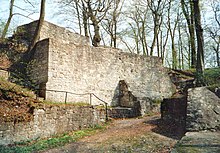Gunzelin from Wolfenbüttel

bronze statue in the pedestrian zone of the city of Peine by Wolfgang Lamché
Gunzelin Wolfenbuttel (* around 1170 , † 2. February 1255 ) was a from Wolfenbüttel originating member of the service team of Guelph , in the state of a ministerial officials of the Empire rose. The first name Gunzelin was a common nickname of Gunther .
family
Gunzelin (Guncelin) was the son of Ekbert I. von Wolfenbüttel, Vogt von Heiningen and Ministeriale Heinrichs des Löwen . Gunzelin's great-grandfather was Widekind von Wolfenbüttel , the builder of the Wolfenbüttel moated castle and thus the founder of the city of Wolfenbüttel . From Gunzelin's marriage to a ministerial from Hildesheim , the sons Ekbert III., Burchard III. and Gunzelin II.
Offices
Gunzelin had initially under the Guelph Emperor Otto IV. , Under the later (1175/1176 -1218) and Staufer Emperor Frederick II. (1194-1250), the court office of Steward held. Although a stewardess was originally a minor servant who waited at the table, Gunzelin has traditionally been given military and diplomatic tasks. These tasks consisted, for example, in announcing the arrival of Otto IV for the coronation of emperor in 1209 as envoy to Pope Innocent (1160/1161-1216). Through the military duties imposed on him as a royal and imperial clerk, he became a knight and inherited the county of Peine . At the end of his life he worked in his home country and was a feudal lord of the Hildesheim and Gandersheim monasteries .
To 1202 Gunzelin took over from Wolfenbüttel after a feud with the bishop of Hildesheim Hartbertstrasse the castle Peine . On a headland south of this castle he founded the settlement of Peine around 1220 , which was granted city rights in 1223. Although Peine existed as a castle before Gunzelin, Gunzelin is named as the city founder in the Peiner Chronicles. Among other things, the coat of arms of Pein goes back to Gunzelin, the seal of which represents two sheaves over which a wolf leaps.
His main merit as a general was the conquest of the city of Goslar in 1206. In the same year, at the beginning of June, he took part in the unsuccessful siege against Lichtenberg Castle near Salzgitter. After the death of the Welf emperor in 1218, he submitted to the Hohenstaufen king and later emperor Friedrich II. In 1222 Gunzelin was briefly imperial legate in Tuscany on an imperial mandate . Gunzelin was supposed to win back the Duchy of Spoleto and the Mark of Ancona there . A hasty solo attempt in this matter led to Gunzelin, as governor, being publicly reprimanded by Friedrich before ecclesiastical and secular rulers.
Title and commemoration
His titles and additions to his name were:
- “Von Peine” because of the capture of Peine Castle around 1202 and the foundation of the city of Peine around 1220
- "Von Asseburg" because of the construction of the Asseburg near Wolfenbüttel 1218–1223. With the construction he established the line of those from the Asseburg .
Today a bronze statue (see picture above) of Gunzelin von Wolfenbüttel stands in the pedestrian zone of the city of Peine. The sculpture, erected in 1999, is an artistically free representation of the nobleman, of whom no contemporary portraits have survived.
Castle building

From 1218 Gunzelin was involved in the construction of the Asseburg on the Asse , which was built as a Ganerbeburg . It was built as the largest hill fort in northern Germany on a narrow mountain ridge and was considered impregnable.
With the castle Gunzelin established itself in the region as a ruler of its own right. With the fortress he did not, as is sometimes assumed, secure the interests of the Staufer Kaiser in Northern Germany; rather, he pursued his own goals. Shortly before Gunzelin's death, the castle was besieged in vain for three years from 1254 by the Guelph Duke Albrecht the Long . Gunzelin's eldest son Burchard (Busso) was the defense attorney. In 1258 Albrecht was finally able to conquer the Asseburg and incorporate it into the Guelph domain.
literature
- Wolfgang Petke: Gunzelin from Wolfenbüttel . In: Horst-Rüdiger Jarck , Dieter Lent et al. (Ed.): Braunschweigisches Biographisches Lexikon - 8th to 18th century . Appelhans Verlag, Braunschweig 2006, ISBN 3-937664-46-7 , p. 282-283 .
- Bernd Ulrich Hucker : Kaiser Otto IV. Hahn, Hanover 1990. ISBN 3-7752-5162-6
- Bernd Ulrich Hucker: Otto IV .: the rediscovered emperor; a biography . Insel Verlag, Frankfurt am Main [u. a.] 2003. ISBN 3-458-34257-5
- Ulrich Schwarz (ed.): On the way to the ducal residence Wolfenbüttel in the Middle Ages. Appelhans Verlag, Braunschweig 2003. ISBN 3-930292-86-6
- Paul Zimmermann : Wolfenbüttel, Günzelin of . In: Allgemeine Deutsche Biographie (ADB). Volume 44, Duncker & Humblot, Leipzig 1898, pp. 1-4.
Individual evidence
- ^ JB Graf von Bocholtz-Asseburg (ed.): Asseburger Urkundenbuch, Volume 1 to 1300, Hanover 1876, family table for the Asseburger Urkundenbuch
- ^ History of the city and office of Peine
- ^ The Braunschweigische Landesgeschichte, Braunschweig 2000. Zeittafel zur Landesgeschichte, p. 1177.
| personal data | |
|---|---|
| SURNAME | Gunzelin from Wolfenbüttel |
| BRIEF DESCRIPTION | Wolfenbüttel member of the Welf service team, who rose to the rank of ministerial of the Reich |
| DATE OF BIRTH | around 1170 |
| DATE OF DEATH | February 2, 1255 |

